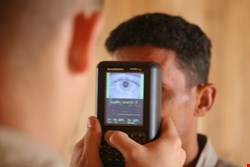Mobile biometrics is rapidly becoming a key human identification platform, transforming how people access business and personal information. Both governments and private industry are turning to mobile biometrics to speed up the processing of people and goods in financial services, law enforcement, military, public transportation, border control, healthcare and commercial shipping.
What is Mobile Biometrics?
‘Mobile biometrics’ simply means achieving individual biometric identification functionality on a mobile device. Biometric functionality can be achieved on a mobile device through built-in sensors or by attaching portable biometric hardware, either via USB cable or through a Wi-Fi connection. A device’s biometric sensors might be limited to one modality, but attaching separate biometric hardware can open the door for the user to select whichever biometric modality they want to use (e.g. fingerprint, palm vein, iris or facial recognition). There is also some multi-modal biometric hardware which provides the benefit of two biometric modalities in one mobile device.
Adopting one technology over another will always involve some trade-offs. Here are a few key points to keep in mind while adopting mobile biometrics:
The Impact on Traditional ID Systems
Biometric human identification can’t always be performed in a controlled office environment. At times, biometric identification might be required to go where people go, perhaps in public venues. For example, in law enforcement, field officers might need to operate in a different location each day where might need to identify suspects.
The popularity of BYOD is also increasing the adoption of mobile biometric technology. Enterprises are utilizing the BYOD concept with biometric security in order to ensure the security of their database. Due to the fact that biometric hardware can be paired with an employee’s mobile phone or smart device, it eliminates the hassle of carrying around a laptop or any other associated device.

Mobile biometric identification is also beneficial when securing high-value financial transactions conducted via mobile. The technology provides the security needed to ensure accuracy and legitimacy, plus biometrics offers a strong audit trail should the need arise. Personal identification numbers (PINs) and pattern-based applications exist, but they don’t offer the level of security that biometrics can provide.
With the launch of Apple’s latest fingerprint-based mobile payment system, Apple Pay, the use of biometric-enabled mobile payments is likely to increase in the coming years. Apple has created a solution that is convenient, smart and secure. A large part of the payments ecosystem has already partnered with them to make the service available to end users. In an attempt to cash in on mobile biometrics’ success, some companies have also come up with similar solutions, like Alipay Wallet from Alibaba and Samsung’s fingerprint-enabled payment via PayPal.
Each day more and more governments and private enterprises are turning to mobile biometrics for human identification. Here are some scenarios where mobile biometrics has changed the way humans are identified:
Law Enforcement
Mobile biometric technologies have been providing benefits to law enforcement agencies for quite some time now. Field agents can now use mobile biometric devices to collect and identify people during field operations in near real time. The use of mobile biometrics to quickly determine the identity of a person can and does save officers’ lives. If a person is identified through mobile biometrics and is known to have a record, an officer may choose a different tactic, technique, or procedure to prevent a dangerous, potentially deadly physical altercation.
Border Control
Mobile biometric technology is used at border control checkpoints and airports to enroll and check citizens and travelers against the existing suspect list. In this process a registered suspect can be identified in the future at a different checkpoint to regulate and prevent the suspicious flow of travelers.
Banks and Financial Institutions
Financial institutions are increasingly implementing mobile biometric technology for customer identification in order to open an account or conduct and authorize a transaction. Mobile biometrics might just become commonplace throughout the world over the next few years to prevent criminals from fraudulently accessing customer data. With mobile biometric payment/banking services, it becomes convenient and safe to access accounts from your very own smartphone with a biometric sensor.
Healthcare
In 2013, the HIPAA omnibus rule came into effect which now recommends the healthcare industry ensures portability, security, and open access to healthcare data, but only to those authorized to access the information. Mobile biometric technology can provide access to healthcare information from remote locations to authorized users. This will eventually increase the quality of healthcare service and helps provide security protection and peace of mind to patients that they are the only individuals with access to their medical data.
With the technology world rapidly evolving from workstation-based to mobile computing, mobile biometric security is becoming a key consideration for protecting personal, corporate, and financial data. The change might be slow, but eventually mobile biometrics will change the way we identify ourselves and others in many settings.
About the Author
Mohammad Shahnewaz is a senior executive at M2SYS Technology and an occasional blogger. His passion is writing about the adoption of government and enterprise biometric identity management technologies and the changes these bring to people’s lives.
